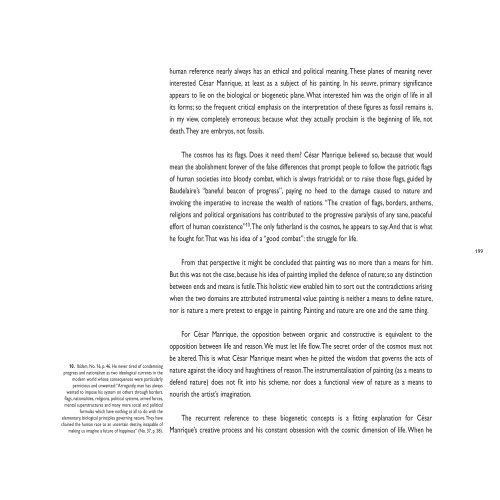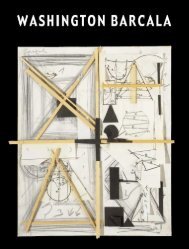VERSIÓN INGLESA ENGLISH VERSION - Fundación César Manrique
VERSIÓN INGLESA ENGLISH VERSION - Fundación César Manrique
VERSIÓN INGLESA ENGLISH VERSION - Fundación César Manrique
Create successful ePaper yourself
Turn your PDF publications into a flip-book with our unique Google optimized e-Paper software.
10. Ibídem, No. 16, p. 46. He never tired of condemning<br />
progress and nationalism as two ideological currents in the<br />
modern world whose consequences were particularly<br />
pernicious and unwanted: “Arrogantly, man has always<br />
wanted to impose his system on others through borders,<br />
flags, nationalities, religions, political systems, armed forces,<br />
mental superstructures and many more social and political<br />
formulas which have nothing at all to do with the<br />
elementary, biological principles governing nature. They have<br />
chained the human race to an uncertain destiny, incapable of<br />
making us imagine a future of happiness” (No. 37, p. 58).<br />
human reference nearly always has an ethical and political meaning. These planes of meaning never<br />
interested <strong>César</strong> <strong>Manrique</strong>, at least as a subject of his painting. In his oeuvre, primary significance<br />
appears to lie on the biological or biogenetic plane. What interested him was the origin of life in all<br />
its forms; so the frequent critical emphasis on the interpretation of these figures as fossil remains is,<br />
in my view, completely erroneous; because what they actually proclaim is the beginning of life, not<br />
death. They are embryos, not fossils.<br />
The cosmos has its flags. Does it need them? <strong>César</strong> <strong>Manrique</strong> believed so, because that would<br />
mean the abolishment forever of the false differences that prompt people to follow the patriotic flags<br />
of human societies into bloody combat, which is always fratricidal; or to raise those flags, guided by<br />
Baudelaire’s “baneful beacon of progress”, paying no heed to the damage caused to nature and<br />
invoking the imperative to increase the wealth of nations. “The creation of flags, borders, anthems,<br />
religions and political organisations has contributed to the progressive paralysis of any sane, peaceful<br />
effort of human coexistence” 10 . The only fatherland is the cosmos, he appears to say. And that is what<br />
he fought for. That was his idea of a “good combat”: the struggle for life.<br />
From that perspective it might be concluded that painting was no more than a means for him.<br />
But this was not the case, because his idea of painting implied the defence of nature; so any distinction<br />
between ends and means is futile. This holistic view enabled him to sort out the contradictions arising<br />
when the two domains are attributed instrumental value: painting is neither a means to define nature,<br />
nor is nature a mere pretext to engage in painting. Painting and nature are one and the same thing.<br />
For <strong>César</strong> <strong>Manrique</strong>, the opposition between organic and constructive is equivalent to the<br />
opposition between life and reason. We must let life flow. The secret order of the cosmos must not<br />
be altered. This is what <strong>César</strong> <strong>Manrique</strong> meant when he pitted the wisdom that governs the acts of<br />
nature against the idiocy and haughtiness of reason. The instrumentalisation of painting (as a means to<br />
defend nature) does not fit into his scheme, nor does a functional view of nature as a means to<br />
nourish the artist’s imagination.<br />
The recurrent reference to these biogenetic concepts is a fitting explanation for <strong>César</strong><br />
<strong>Manrique</strong>’s creative process and his constant obsession with the cosmic dimension of life. When he<br />
199
















![Becas y premios de la Fundación César Manrique [1997-2006]](https://img.yumpu.com/20766851/1/184x260/becas-y-premios-de-la-fundacion-cesar-manrique-1997-2006.jpg?quality=85)
